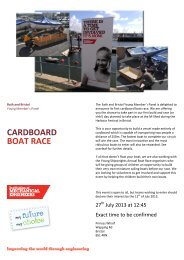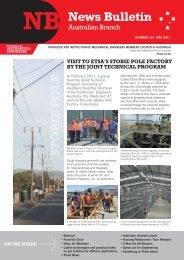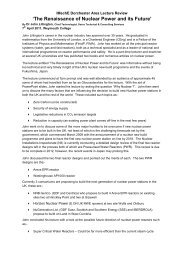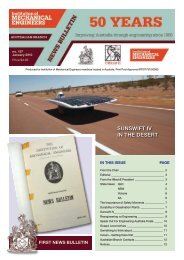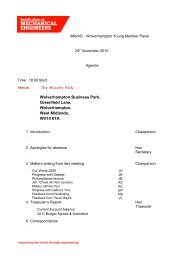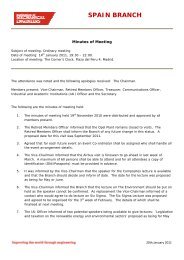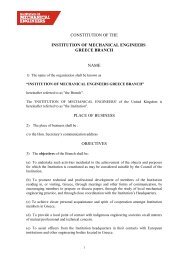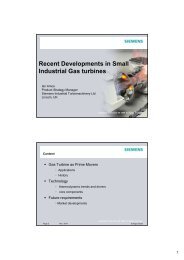The future electricity system – definitely not business as ... - Near You
The future electricity system – definitely not business as ... - Near You
The future electricity system – definitely not business as ... - Near You
You also want an ePaper? Increase the reach of your titles
YUMPU automatically turns print PDFs into web optimized ePapers that Google loves.
Are we running out of energy<br />
<strong>The</strong> <strong>future</strong> <strong>electricity</strong> <strong>system</strong> <strong>–</strong> <strong>definitely</strong> <strong>not</strong> <strong>business</strong> <strong>as</strong> usual<br />
John Cherrie
• Electricity <strong>–</strong> the first 100 years<br />
Contents<br />
• <strong>The</strong> next ten years <strong>–</strong> more change than in the<br />
l<strong>as</strong>t 100<br />
<strong>–</strong> Demand<br />
<strong>–</strong> Supply<br />
<strong>–</strong> Networks<br />
• Challenges
<strong>The</strong> Power System Today<br />
• Demand is what it is <strong>–</strong> we observe it but don’t<br />
control it (much…)<br />
• Most generation h<strong>as</strong> outputs controllable to varying<br />
degrees (g<strong>as</strong>, coal, nuclear, most hydro)<br />
• A small amount of generation is self-dispatching<br />
(wind, solar PV, some hydro, CHP)<br />
• Operating the <strong>system</strong> means following demand<br />
second by second by controlling generation in ways<br />
that burn le<strong>as</strong>t fuel whilst respecting technical limits
<strong>The</strong> Power System Today<br />
• Demand is what it is <strong>–</strong> we observe it but don’t<br />
control it (much…)<br />
• Most generation h<strong>as</strong> outputs controllable to varying<br />
degrees (g<strong>as</strong>, coal, nuclear, most hydro)<br />
• A small amount of generation is self-dispatching<br />
(wind, solar PV, some hydro, CHP)<br />
• Operating the <strong>system</strong> means following demand<br />
second by second by controlling generation in ways<br />
that burn le<strong>as</strong>t fuel whilst respecting technical limits<br />
I could have written this 100 years ago
<strong>The</strong>rmal power plants<br />
Hydro power plants<br />
Transmission network<br />
Wind farms<br />
Today’s power <strong>system</strong><br />
Distribution networks<br />
commercial customers<br />
Industrial customers<br />
residential customers
National Grid Demand (MW)<br />
33500<br />
33000<br />
32500<br />
32000<br />
31500<br />
31000<br />
Challenges in today’s world<br />
England v Germany Sunday 27th June 2010 ko 15:00<br />
Result 1-4<br />
15:00<br />
Kick-off<br />
30500<br />
1430 1445 1500 1515 1530 1545 1600 1615 1630 1645 1700 1715 1730<br />
Source: UK National Grid<br />
15:45 Half Time<br />
1020MW<br />
Time<br />
16:49 Full Time<br />
640MW<br />
27th June 2010<br />
28th June 2009
<strong>The</strong> <strong>future</strong> world<br />
• Carbon reduction<br />
• Supply security<br />
• Fuel cost<br />
• Need to build or replace generating capacity<br />
• New technology across supply, transport and<br />
utilisation<br />
• Shale g<strong>as</strong> and unconventional oil?<br />
• All in a context of high global uncertainty<br />
Pretty well everything that h<strong>as</strong> been a fixed point<br />
in power <strong>system</strong> planning is now potentially a variable
• Tending to reduce<br />
<strong>–</strong> Efficient buildings<br />
<strong>–</strong> Heat storage<br />
<strong>–</strong> Efficient industry<br />
<strong>–</strong> Efficient lighting<br />
<strong>–</strong> Efficient appliances<br />
• Becoming controllable<br />
<strong>The</strong> <strong>future</strong> of <strong>electricity</strong> demand<br />
• Tending to incre<strong>as</strong>e<br />
<strong>–</strong> Switch to electric<br />
transport<br />
<strong>–</strong> Individual control of time shiftable demand<br />
<strong>–</strong> Sophisticated metering to set incentives<br />
<strong>–</strong> Engaging consumers?<br />
Very uncertain how f<strong>as</strong>t this will evolve<br />
<strong>–</strong> Switch to heat pumps<br />
from fossil heating<br />
<strong>–</strong> New uses for <strong>electricity</strong>
• Better choice of using <strong>electricity</strong><br />
• Reduction of bills<br />
<strong>–</strong> Responding to time-of-use tariff,<br />
or<br />
<strong>–</strong> Sign-on a deal with your supplier<br />
by “being flexible”, smart<br />
charging/using<br />
• Participation in the <strong>electricity</strong> value<br />
chain<br />
• Reduction of <strong>electricity</strong>/energy<br />
consumed<br />
• Reduction of emissions<br />
• Sustainability<br />
Example <strong>–</strong> the smart home<br />
System<br />
operator<br />
Smart home<br />
from EPRI source image
Electric transport<br />
• Low carbon personal transport options<br />
<strong>–</strong> Biofuels<br />
• Generally scale limited by available resource,<br />
competition with food supplies<br />
<strong>–</strong> Hydrogen<br />
• Need very large scale hydrogen sources, <strong>not</strong> clear where from?<br />
Possible use for surplus wind generation.<br />
<strong>–</strong> Electric<br />
• Some significant challenges but currently the preferred option.<br />
Hybrids?<br />
<strong>–</strong> Walk, cycle, take the (electric) train<br />
• All have a role, but all studies indicate people are very reluctant to<br />
give up personal mobility once they have gained it
Power <strong>system</strong> implications of electric vehicles<br />
• 32m cars in UK<br />
• Assume 10m plug in at<br />
the same time and each<br />
takes 8 kW<br />
• Power <strong>system</strong> demand<br />
from cars =80 GW<br />
• Current UK maximum<br />
demand=60 GW<br />
• Current UK installed<br />
generation=75 GW<br />
• 10 houses in your street<br />
• Average street<br />
demand=10 kW<br />
• Assume 5 cars plug in<br />
together, taking 8 kW<br />
each<br />
• Extra load on street<br />
distribution feeder=40<br />
kW<br />
Uncontrolled adoption of EVs will break the power <strong>system</strong>!<br />
But charging can be controlled<br />
<strong>–</strong> provided EVs are plugged in when <strong>not</strong> in use!
Power Systems Implications of Electric Heating<br />
• Substitution of g<strong>as</strong> or oil fuel<br />
• Ground Source Heat Pumps<br />
<strong>–</strong> Highly efficient and becoming more so<br />
<strong>–</strong> Need area of land from which to source the heat<br />
<strong>–</strong> Not suited to some lifestyles<br />
• Air Source Heat Pumps<br />
<strong>–</strong> Less cost effective than GSHP<br />
<strong>–</strong> Far less restricted in application<br />
<strong>–</strong> Not suited to some lifestyles<br />
• Linkage to heat storage<br />
<strong>–</strong> Hot water storage within the day<br />
<strong>–</strong> Longer term storage depending on building and geology<br />
• 20 million 1.5 kWe heat pumps <strong>–</strong> 30 GW
• System Level<br />
<strong>–</strong> Demand might double<br />
through fuel substitution<br />
<strong>–</strong> Most of this new demand is<br />
time shiftable to a degree<br />
<strong>–</strong> Most of the time shiftability is<br />
within the day, <strong>not</strong> over<br />
longer periods<br />
<strong>–</strong> Without a way to manage<br />
demand, net impact is a<br />
much larger demand<br />
problem, with growth across<br />
the 24 hours<br />
Issues and opportunity in demand<br />
• Street Level<br />
<strong>–</strong> F<strong>as</strong>hion effect <strong>–</strong> single streets<br />
full of early adopters of EVs<br />
and ASHPs?<br />
<strong>–</strong> Local demand incre<strong>as</strong>es<br />
x2…x5?<br />
<strong>–</strong> M<strong>as</strong>sive need to reinforce<br />
local networks<br />
<strong>–</strong> Management of demand<br />
becomes essential to turn this<br />
into a manageable size of<br />
problem<br />
Both a problem and an opportunity in a<br />
world where generation sources are significantly intermittent
• Utility Scale<br />
<strong>–</strong> G<strong>as</strong> (CCS)<br />
<strong>–</strong> Coal (CCS)<br />
<strong>–</strong> Nuclear<br />
<strong>–</strong> Hydro<br />
<strong>–</strong> Onshore Wind<br />
<strong>–</strong> Offshore Wind<br />
<strong>–</strong> Biom<strong>as</strong>s and w<strong>as</strong>te<br />
<strong>–</strong> Wave and tidal stream<br />
<strong>–</strong> Tidal barrage<br />
Generation <strong>–</strong> a story of diversity<br />
• Local scale<br />
<strong>–</strong> CHP on fossil fuel<br />
<strong>–</strong> CHP on biom<strong>as</strong>s<br />
<strong>–</strong> Solar PV<br />
<strong>–</strong> Hydro<br />
<strong>–</strong> Small wind<br />
<strong>–</strong> “nuke in a box”???<br />
• Other (<strong>not</strong> UK at any scale)<br />
<strong>–</strong> CSP<br />
<strong>–</strong> Geothermal<br />
<strong>–</strong> Utility scale solar PV
Generation flexibility now compared to <strong>future</strong><br />
Technology<br />
Coal non CCS<br />
G<strong>as</strong> CCGT non CCS<br />
Nuclear non PWR<br />
Coal CCS<br />
G<strong>as</strong> CCGT CCS<br />
Wind onshore<br />
Wind offshore<br />
Hydro<br />
Biom<strong>as</strong>s<br />
Wave/tidal<br />
Tidal Barrage<br />
Nuclear PWR<br />
UK Scale Now<br />
Large<br />
Large<br />
Large<br />
None<br />
None<br />
Small<br />
Small<br />
Small<br />
Small<br />
None<br />
None<br />
Small<br />
UK Scale 2020/30+<br />
Small<br />
Smaller than now<br />
None<br />
Large<br />
Large<br />
Medium<br />
Large<br />
Small<br />
Medium<br />
Medium?<br />
None/Large<br />
Large<br />
Flexibility<br />
Good<br />
Good<br />
None<br />
?? OK<br />
?? OK<br />
Self dispatch<br />
Self dispatch<br />
Good<br />
OK<br />
Self dispatch<br />
Self dispatch<br />
Limited
Coal with carbon capture<br />
• Coal currently about 30% of UK<br />
GWh<br />
• Technology <strong>not</strong> proven in<br />
aggregate but applied piecemeal<br />
before<br />
• Move to (ultra)supercritical plant<br />
in parallel with CCS<br />
developments?<br />
• CCS flexibility predicted to be<br />
re<strong>as</strong>onable but no experience to<br />
prove it<br />
• (U)SC plant flexibility <strong>not</strong> <strong>as</strong> good<br />
<strong>as</strong> current subcritical fleet<br />
• UK h<strong>as</strong> recently cancelled support<br />
to first CCS project but keeps<br />
looking. Possible EU support.<br />
Seems almost certain than flexibility will be reduced<br />
compared to present coal fleet, but some may remain.<br />
Will it happen in UK?
G<strong>as</strong> with carbon capture<br />
• A technology still in development<br />
• More difficult than coal to capture the CO 2<br />
because it is more dilute in the exhaust<br />
stream<br />
• Seems likely to have similar flexibility to coal<br />
CCS (ie. re<strong>as</strong>onable but <strong>not</strong> <strong>as</strong> good <strong>as</strong> today’s<br />
unabated CCGT plant)<br />
• Likely to move up the political agenda to avoid<br />
a d<strong>as</strong>h for shale g<strong>as</strong>… or <strong>not</strong><br />
Some flexibility seems likely, and (subject to regulations)<br />
you could always turn off the CCS to gain flexibility!
Nuclear<br />
• Received wisdom: Nuclear=b<strong>as</strong>eload ie inflexible<br />
• PWR fleets in France and Germany can load follow to a<br />
degree<br />
• Latest designs appear to have more inherent flexibility<br />
• Concerns over thermal cycling shortening plant life<br />
significantly if this is done aggressively<br />
• Very little experience to go on<br />
• Plant owners may be reluctant to flex their new $5bn <strong>as</strong>sets<br />
in this context<br />
• Impact of Fukushima on financeability and public acceptance?<br />
• Impact of Flamanville cost overruns on confidence?<br />
<strong>The</strong>re is some flexibility in nuclear, but<br />
at a practical level nobody quite knows how much yet!
Wind<br />
• Self dispatching plant with annual load factors typically<br />
between 20% and 45%<br />
• What matters for the power <strong>system</strong> is <strong>not</strong> annual load factor<br />
but hour by hour generation<br />
• Some lack of correlation across different UK sites (and more<br />
across Europe generally), which gives some diversity<br />
• Significant periods of sustained high output and sustained<br />
close to zero output across a UK portfolio (and also a<br />
European portfolio, but to a lesser degree)<br />
• Short term wind forec<strong>as</strong>ting (hour ahead) is good and<br />
improving<br />
• Plans for 33 GW of wind in UK by around 2025<br />
<strong>–</strong> Current maximum demand=60 GW, minimum demand=35 GW<br />
Wind at this scale will have a major impact<br />
on flexibility requirements of other generation and/or demand
Source: Poyry<br />
Wind correlations
• Small in UK but big<br />
elsewhere<br />
• Very flexible if water is<br />
available<br />
<strong>–</strong> Irrigation demands?<br />
<strong>–</strong> Modern schemes tend to<br />
have less reservoir<br />
storage to reduce<br />
environmental impact<br />
<strong>–</strong> Some schemes are<br />
entirely run of river and<br />
self dispatch<br />
Hydro
• Probably <strong>not</strong> large in UK<br />
•Potential large scale opportunities<br />
in N Africa exporting to Europe<br />
•Very large opportunities in some<br />
countries (need sun, space)<br />
• Load factors typically 17-20%<br />
•Output can correlate nicely with<br />
peak demands (air conditioning)<br />
•Predictability depends on location<br />
•Salt storage possible for CSP<br />
technologies<br />
Solar
Biom<strong>as</strong>s and w<strong>as</strong>te<br />
• Various technologies<br />
• Currently preferred plant at large scale is m<strong>as</strong>s<br />
burn<br />
• This looks like coal plant with additionally<br />
complicated fuel handling, <strong>as</strong>h handling and<br />
emissions control<br />
• In principle this plant is flexible, but <strong>not</strong> yet<br />
really tested<br />
• Scale in UK for <strong>electricity</strong> - medium
Wave,Tidal Stream, Tidal Barrage<br />
• Still at development/early deployment stage<br />
except for barrages, which are proven<br />
• Output is intermittent but predictable<br />
• Maintenance availabilities <strong>not</strong> yet clear<br />
• Scale is potentially large if cost can be brought<br />
down, but that seems challenging at the<br />
moment
Comparative generating costs, b<strong>as</strong>e c<strong>as</strong>e<strong>–</strong> 2009 start<br />
£/MWh<br />
Capital Costs Fixed operating Costs Variable Operating Costs Fuel Costs<br />
Carbon Costs Decomm and w <strong>as</strong>te fund CO2 transport and storage<br />
200<br />
180<br />
160<br />
140<br />
120<br />
100<br />
80<br />
60<br />
40<br />
20<br />
-<br />
G<strong>as</strong> Plant - CCGT<br />
G<strong>as</strong> Plant - CCGT<br />
with CCS<br />
Coal Plant - Pulversied<br />
fuel, ASC with FGD<br />
Coal Plant - Pulversied<br />
fuel, ASC with FGD<br />
and CCS<br />
Coal Plant - Pulversied<br />
fuel, ASC with FGD<br />
and retro-fitted CCS<br />
Coal Plant - IGCC<br />
Coal Plant - IGCC with<br />
CCS<br />
Wind - Onshore Wind<br />
Wind - Offshore Wind<br />
Wind - Offshore Wind<br />
R3<br />
Nuclear - Compact<br />
modular PWR
Generation - conclusions<br />
• Large amounts of wind will drive other<br />
generation to be more flexible<br />
• But most other generation is becoming less<br />
flexible<br />
• Significant uncertainties over <strong>future</strong> flexibility<br />
of coal CCS, g<strong>as</strong> CCS, new nuclear<br />
• Other countries will have their own version of<br />
this problem
Source: Poyry<br />
Hour by hour flexibility requirement
Solutions<br />
• International interconnection to smooth the<br />
problem<br />
• Integrate demand management via a smart<br />
grid<br />
• More storage<br />
• Lots of low cost peaking power
With<br />
NW Europe<br />
Ireland<br />
Norway<br />
Iceland<br />
North Sea<br />
Supergrid<br />
Med/N Africa<br />
Exisiting GW<br />
2<br />
0.5<br />
0<br />
0<br />
0<br />
0<br />
Interconnection possibilities<br />
Future GW<br />
5?<br />
1?<br />
1<br />
1<br />
10+<br />
10+<br />
Comment<br />
Seems serious<br />
Seems serious<br />
Longer term<br />
Uncertain<br />
Uncertain
What would more European interconnection deliver?<br />
• Less correlated renewables across Europe<br />
• More diverse renewables (potentially hydro,<br />
solar, geothermal <strong>as</strong> well <strong>as</strong> wind)<br />
• Ability to share peaking and backup capacity<br />
• More work needed to understand costs,<br />
benefits and limitations<br />
• To make a difference on a European scale,<br />
capacities would need to be many 10s of GW
Management of demand <strong>–</strong> the smart grid<br />
• Key to enabling demand to participate<br />
• Mostly around IT and me<strong>as</strong>urement/control<br />
at very high granularity<br />
<strong>–</strong> Distribution substation level<br />
<strong>–</strong> House level<br />
<strong>–</strong> Appliance level<br />
• Requires sophisticated metering, comms and<br />
tariff platforms<br />
• An intensive R, D and D area worldwide
Fossil-fuel power plants<br />
Offshore wind<br />
nuclear power plants<br />
Transmission control centres<br />
Transmission networks<br />
Industry loads<br />
Represents two-way power and data flows<br />
Illustration of a Smart Grid<br />
Commercial customers<br />
distribution control centres<br />
distribution networks<br />
Distributed CHP<br />
Distributed generation<br />
Customers with smart meter, electric vehicle,<br />
and PV panel and heat pumps<br />
Smart home, with PV, storage<br />
and smart meters
Benefits to the power network owner<br />
• Improved efficiency of investment in power <strong>as</strong>sets<br />
<strong>–</strong> i) incre<strong>as</strong>ing the utilisation;<br />
<strong>–</strong> ii) deferring building new <strong>as</strong>sets; and<br />
<strong>–</strong> iii) facilitating demand response<br />
• Integration of intermittent renewable generation<br />
• Emission reductions <strong>–</strong> low carbon<br />
• Enhancement of power <strong>system</strong> security<br />
• Quality and reliability of power supply incre<strong>as</strong>ed<br />
• Improved power network operational efficiency
Challenges - Technical<br />
• Handling of mega data<br />
<strong>–</strong> Data privacy<br />
<strong>–</strong> Cyber security<br />
<strong>–</strong> Architecture<br />
• Standardization and interoperability<br />
• True readiness of technologies<br />
• Full understanding of technologies and implications of deployment<br />
• Capital constraints<br />
• Approvals<br />
• Policy and financial incentives
Challenges - Institutional<br />
• Much greater need for stakeholders to work<br />
together<br />
<strong>–</strong> Network utilities<br />
<strong>–</strong> Municipalities<br />
<strong>–</strong> Landlords and householders<br />
<strong>–</strong> Operators of car parks<br />
<strong>–</strong> Vehicle and appliance manufacturers<br />
<strong>–</strong> Government<br />
• Difficulties in defining the <strong>business</strong> c<strong>as</strong>e <strong>–</strong> costs are<br />
borne by different parties to those who benefit<br />
• Consumer engagement
“I don’t pay the bill, why<br />
should I change my behaviour”<br />
“I don’t trust RWE or EdF to know<br />
when I’m using energy”<br />
“W<strong>as</strong>hing clothes at night,<br />
whatever next?”<br />
“Why should I have to<br />
worry about all this?”<br />
Consumer engagement<br />
• Inconvenience<br />
• Privacy<br />
• Time spent<br />
• Learning needed<br />
• Priority versus other<br />
things
• Cost savings (versus<br />
other low carbon<br />
options)<br />
• People feel they “own”<br />
their domestic energy<br />
economy<br />
• Helps promote<br />
behaviour that avoids<br />
w<strong>as</strong>te<br />
• F<strong>as</strong>hionable?<br />
Consumer engagement<br />
“I like the cheaper price, and<br />
don’t mind the minor inconvenience”<br />
“My smart meter tells me a lot<br />
about how much I w<strong>as</strong>te <strong>–</strong> it’s<br />
changed my outlook on helping<br />
to save the planet”<br />
“I’ve contracted with a service<br />
company, they take care of<br />
everything”
Smart Grid Costs<br />
• Not clear at the moment<br />
• Main elements are:<br />
<strong>–</strong> Metering<br />
<strong>–</strong> Data processing and communications<br />
<strong>–</strong> Sensing and<br />
<strong>–</strong> Sophisticated energy management <strong>system</strong>s<br />
<strong>–</strong> Home automation<br />
• Alternatives (heavy network reinforcement, standby<br />
thermal generation) are much higher cost<br />
• All <strong>future</strong>s will be substantially more expensive than<br />
today if decarbonisation remains a priority<br />
A major policy conundrum <strong>–</strong> will need to be<br />
conceived and partly built ahead of need
• Pumped storage<br />
• Compressed Air<br />
• Flywheels<br />
• Cryogenics<br />
• Battery<br />
• Electric vehicle<br />
batteries?<br />
• Other<br />
• Duration of storage<br />
Storage<br />
• Round trip efficiency<br />
• Capex, opex<br />
• Dispatchability<br />
Potentially very significant, but costs tend to be large
Open cycle GTs and diesels <strong>–</strong> get out of jail (almost)<br />
free<br />
• Cheap<br />
• Rapidly deployable<br />
• Technically proven<br />
• Very flexible<br />
• BUT<br />
<strong>–</strong> Inefficient (25-40%)<br />
<strong>–</strong> High carbon<br />
<strong>–</strong> Use scarce fuels (GTs)<br />
<strong>–</strong> Concerns over other emissions if non premium fuels used (diesels)<br />
• <strong>The</strong> problem solver of choice in countless countries whose<br />
energy policies have gone wrong!<br />
Nobody wants to admit it, but they will have<br />
a role, it’s just a question of how big a role.
Conclusions<br />
• Lots of unsolved problems <strong>–</strong> great for <strong>future</strong> energy<br />
engineers<br />
• Policymakers are just beginning to recognise the<br />
complexity of the issue<br />
• Modelling is complex and full of uncertainty<br />
• Solutions will require a high degree of integration<br />
across disciplines and along value chains<br />
• This presentation h<strong>as</strong> focussed on UK, every country<br />
h<strong>as</strong> its own version of this problem, they are all<br />
different<br />
How would this look in your country (if <strong>not</strong> UK)?
www.mottmac.com



